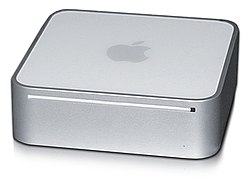Apple–Intel architecture
| Mac transition to Intel processors |
|---|
 |
The Apple–Intel architecture, or Mactel, is an unofficial name used for Apple Macintosh personal computers[citation needed] developed and manufactured by Apple Inc. that use Intel x86 processors, rather than the PowerPC and 68k processors used in their predecessors.
Technologies
Apple uses a subset of the standard PC architecture, which provides support for Mac OS X and support for other operating systems. Hardware and firmware components that must be supported to run an operating system on Apple-Intel hardware include the Extensible Firmware Interface.
Virtualization
The Intel Core Duo, Core 2 Duo, Core i5, Core i7, and Xeon processors found in Intel Macs support Intel VT-x, which allows for high performance (near native) virtualization, which gives the user the ability to run and switch between two or more operating systems simultaneously, rather than having to dual-boot and run only one operating system at a time.
The first software to take advantage of this technology was Parallels Desktop for Mac, which was released in June 2006. VMware offers a similar product, called Fusion, which was released August 2007. There are many subtle differences between the two products; however, regardless of the product used, there are always likely to be some limitations and inconveniences of using a virtualized guest OS, versus the native solution offered by Boot Camp. Therefore, the best choice depends on the circumstances. Though, both Parallels and VMware's virtualization products allow users to use native (boot camp installations) of Windows XP, Windows Vista, or Windows 7 in a virtualized mode while running OS X.
VirtualBox is another virtualization software from Oracle Corporation, which was released January 2007. Available for multiple host operating systems, including Mac OS X, that can run multiple other guest operating systems, including Windows XP/Vista/7. VirtualBox is available free of charge, under either a proprietary license or the GPL free software license. VirtualBox also supports Intel VT-x.
Extensible Firmware Interface
Extensible Firmware Interface (EFI) is the firmware-based replacement for the PC BIOS from Intel. Designed by Intel, it was chosen by Apple to replace Open Firmware, used on PowerPC architectures. Since many operating systems, such as Windows XP and many versions of Windows Vista, are incompatible with EFI, Apple has released a firmware upgrade with a compatibility support module that provides a subset of traditional BIOS support with their Boot Camp product.
GUID Partition Table
GUID Partition Table (GPT) is a standard for the layout of the partition table on a physical hard disk. It is a part of the Extensible Firmware Interface (EFI) standard proposed by Intel as a substitute for the more common PC BIOS. The GPT replaces the Master Boot Record (MBR) used with BIOS.
Booting
Intel Macs can boot in two ways: directly via EFI, or in a "legacy" BIOS compatibility mode. For multibooting, holding down "Option" gives a choice of bootable devices, while the rEFInd bootloader is commonly used for added configurability.
Standard Live USBs cannot be used on IntelMacs; the EFI firmware can recognize and boot from USB drives, but it can only do this in EFI mode–when the firmware switches to BIOS mode, it no longer recognizes USB drives, due to lack of a BIOS-mode USB driver. Many operating systems, such as Windows and Linux,[1] can only be booted in BIOS mode, or are more easily booted or perform better when booted in BIOS mode, and thus USB booting on IntelMacs is largely limited to Mac OS X, which can easily be booted via EFI. This limitation could be fixed by either patching the Apple firmware to include a USB driver in BIOS mode, or the operating systems to remove the dependency on the BIOS.
Running operating systems other than Mac OS X

On April 5, 2006, Apple made available for download a public beta version of Boot Camp, a collection of technologies which allows users of Intel-based Macs to boot Windows XP Service Pack 2.[2] On March 28, 2007, Boot Camp 1.2 Beta was released which supports Windows Vista. The final version of Boot Camp is included in Mac OS X v10.5, "Leopard".
Linux can also be booted with Boot Camp.[3]
Prior to Boot Camp, which provides most hardware drivers for Windows XP, drivers for XP were very difficult to find.
Dont Steal Mac OS X.kext
Dont Steal Mac OS X.kext, sometimes referred to as DSMOS or DSMOSX, is a file present in Intel-capable versions of the Mac OS X operating system which enforces a form of Digital Rights Management, preventing Mac OS X being installed on stock PCs. The name of the kext is a reference to the Mac OS X license conditions, which allow installation on one piece of Apple hardware only. According to Apple, anything else is stealing Mac OS X. The kext is located at /System/Library/Extensions on the volume containing the operating system.[4] The extension contains a kernel function called page_transform() which performs AES decryption of "apple-protected" programs. A Mac OS X system which is missing this extension, or a system where the extension has determined it's not running on Apple hardware, will be missing this decryption capability, and as a result will not be able to run the Apple-restricted binaries Dock, Finder, loginwindow, SystemUIServer, mds, ATSServer, backupd, fontd, translate, or translated.[5]
See also
Notes
- ^ Linux and X.org rely on BIOS mode to initialize the video hardware, and hence under EFI-booting, Linux and X do not have hardware accelerated video.
- ^ Apple makes Macs run Windows XP
- ^ Mactel Linux
- ^ Victor Mihailescu (January 13, 2006). "Don't Steal Mac OS X!". Softpedia. Retrieved 2007-01-17.
- ^ Amit Singh. "Understanding Apple's Binary Protection in Mac OS X".
